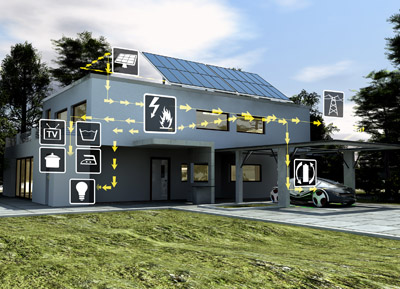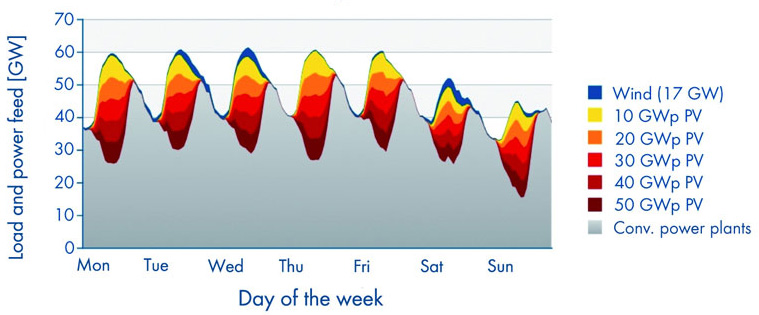Chapter 6 - Energy Sustainability
Part 3 - Electricity: Transmission, Distribution and Economics
Delivering Electricity to End Users
G. Small-Scale Power: Distributed Generation

The technology advancement called Distributed Generation (DG) puts smaller generators closer to loads, and thus has the potential to avoid transmission and distribution altogether. DG is also known as Distributed Energy Resources (DER), which includes other non-generation resources such as energy storage, or demand-side load reduction.
Some of the DG technologies of primary interest today include:
- Reciprocating engines (diesel, spark-ignition natural gas)
- Small turbines (1-20MW)
- Microturbines (30kW-1MW)
- Fuel Cells, which can convert natural gas or hydrogen directly to electricity, no combustion
- Renewables (mainly solar and wind, some small hydro)
As of 2005, the Electric Power Research Institute estimates that 30GW of distributed energy generation is connected to the US, which is only 3% of the total US installed generating capacity. Most of these generators are emergency standby generators, and are not in everyday use.
DG – Barriers and Drivers
Some of the Barriers challenging distributed generation are the following:
- The Efficiency not as high for some technologies, since smaller systems (microturbines) are not yet able to achieve the high efficiencies of the best centralized power plants (CCNG).
- Generation of Power is Not company’s core business – most companies are not in the energy business and do not want to take on the added responsibilities for managing an onsite utility.
- Line worker safety is more of an issue with DG systems, since T&D systems are designed to be monodirectional. Newer interconnection standards for DG are being designed to address this concern.
- Not economically competitive with wholesale costs at smaller scales or without cogeneration.
- Resistance from utilities – entrenched monopoly provider perspective, not much interest in doing things another way, especially for customers who want to buy less of their product
- Interconnection standards are different across different parts of the country, and this makes installation difficult and expensive, increasing costs to DG providers and users alike.
Some of the DG Drivers that are helping to further the implementation of the technology are the following:
- Avoided T&D Losses -by locating generation near the loads, transmission can be avoided altogether, producing a 5 – 10% boost financially and environmentally.
- Modularity –DGs smaller size makes deployment much more flexible, being able to be used in smaller increments, have shorter load times, lower maintenance costs, enhanced reliability
- Technological advances in materials, process control, communication and other relevant technologies are rapidly improving the competitiveness and feasibility of many DG technologies.
- Economically competitive -as technology advances, DG is becoming more useful and economically competitive, with cogeneration being competitive with wholesale costs.
- DG Technologies – Economics
A closer look at the economics of DG technologies when compared to the already existing generation technologies shows that a combustion turbine, rated at 40 MW ranks the lowest as far as the range of total energy cost in $/kWh, at about $0.07/kWh. A diesel engine rated at 1MW costs between $0.18 and $0.35/kWh, while a diesel engine rated at 60MW costs between $0.27 and $0.53/kWh. The retail rate range is from $0.07 - $0.22 or higher, depending on load factor, rate design and the utility.
Energy Storage for Electricity – Benefits

In order to assess the benefits of energy storage for electricity, it is often productive to look at the load profile of a facility. A load profile of a large scale energy production or storage facility is represented graphically as system demand in GW, MW or kW (y-axis) versus time of day (x-axis). Storage is charged during the periods of baseload, and this energy is used to answer the demands made during peak times. Storage of electrical energy has many benefits, with some of the more important ones being the following:
- Enhancing renewables – transforming “take it when you can get it” into scheduled power, allowing a fuel-free electricity source in peak markets
- Support of DG – micro – mini grids and on-site power systems must become at least as reliable as traditional grid-supplied electricity. Today’s digital society/economy demands power quality several orders of magnitude higher. Storage assets placed at distribution voltage substations and integrated into advanced DG devices and uninterruptible power systems need to become the norm.
- Vehicle-to-grid – as electric vehicles become mainstream, their batteries can serve as controllable distributed electricity storage.
Energy Storage for Electricity – Prospects
Energy can be stored chemically (e.g. hydrogen), biologically (e.g. glycogen), electrochemically (e.g. batteries), electrically (e.g. capacitors), mechanically (e.g. flywheels, hydroelectic up-pumping), and themally (e.g. molten salts, solar ponds). Both distributed and centralized energy storage technologies will need to improve performance and economics to make major market inroads in the electricity market. However, when they do, they have the potential to change the nature of the electricity business in very fundamental ways, as electricity will no longer be a strictly non-storable commodity. Among the technologies being examined in this area, CAES, or Compressed Air Energy Storage appears to have to most potential, with a relatively low installation cost as compared to operating cost, a relatively long lifetime, and a high discharge time versus power rating.
Part 3 - Electricity: Transmission, Distribution and Economics
Delivering Electricity to End Users
A. Basic Structure of Electric Power System
B. Transformer Basics and Losses
C. Transmission Lines and Grid Operations
D. Environmental, Health and Safety Issues – T&D
E. System Losses Weigh Heavily on Electricity Systems in Developing Countries
F. A Revolution in the Electricity Sector?
G. Small-Scale Power: Distributed Generation
Summary: Smart-Grid: A Game-Changing Technology (NEXT)
Electricity Markets and the Future of Electricity
(Adapted from the Energy Resources lecture materials of Jane Woodward, Consulting Associate Professor of Civil and Environmental Engineering and Karl Knapp, Lecturer of Civil and Environmental Engineering at Stanford University by Cheryl Chadwick/Gregory Möller)
(Image credits: Siemens AG; Solar Technology AG)

